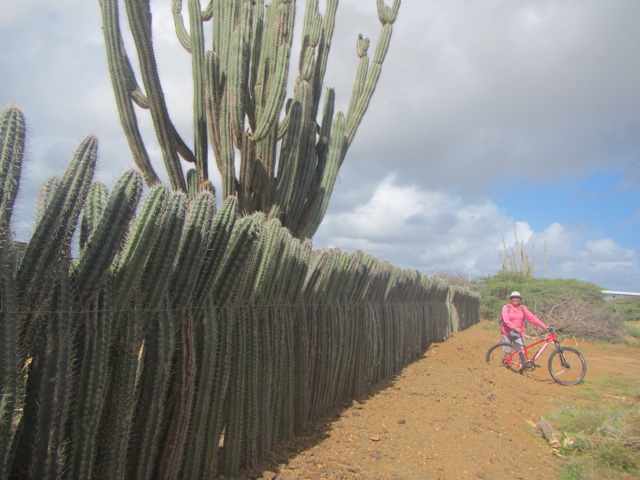There is a flamingo sanctuary on the island and we were lucky to get some pictures of the ones that were close to shore. These flamingoes are really pink, the algae and the shrimp here must be really colourful. At the south end of the island there is a salt mine , the water is collected in pans and it is gradually evaporated leaving the salt to be harvested. The pans that partially evaporated water have a pinkish hue caused by the same algae that makes the flamingoes such a gorgeous colour.
The only other town on the island besides the capital Kralendijk, is Rincon. It is located in a valley where in the past the residences were hidden from the Pirates and safe from the big winds which can assault the island. Slavery exist d here until 863, and the slaves worked out N the salt mines and N the plantations near Rincon. The slaves had to walk eight to nine hours from the salt mines to their homes in Rincon, they worked five days on and two days off and during those two days had to walk home and back. There was a stop in Rincon where you could taste Cactus liqueur. An enterprising Dutchman has been brewing this as well as a different liqueur for each Dutch Island in the Caribbean.
The former slave houses have been rebuilt to provide a reminder of what conditions were like 150 years ago. These small houses were built by the Dutch, once slavery became unpopular, to prove that they were treating their slaves well. These small dwellings were sleeping quarters for four adult men. Once slavery was abolished the slaves were given some land to farm, but the conditions for growing anything on the island are very poor. The soil is nonexistent on this island of coral and limestone. Eons ago the water level was higher as evidenced by this former coast line about two meters above the present one.
We learned a lot about the flora and fauna on the island. One of the local culinary specialities is iguana soup. The first inhabitants lived here in 1400 BC and they used everything that was available . The thorns of the acacia trees were used as nails and the insides of the tall cacti were used for rope. There are mesquite trees which are still being used to make charcoal. There are mostly small scrubby trees and bushes that make up the vegetation on the island.
The Spaniards introduced goats and donkeys to the island and they are running wild all over the island now. There are lots of lovely birds here and I was happy to see a hummingbird this afternoon.
We have been on five dives since we arrived. The first was with the dive company and they took us to the salt mine pier. The long pillars that were sunk for the dock projected up through the water and it felt like I wa in outer space. There were fish above and below us and the coral attached to the pillars was unusual and different. We saw a barracuda there that was larger than Barry! We took our first dives on our own , taking the dinghy to four different dive spots. The first day we had all the gear plus four tanks and we found the dinghy was just too small, so the next day we did a dive in the morning, went back to the boat for lunch and exchanged tanks then did the second dive later in the day. It was really special to be on our own, exploring underwater sites, we saw some spotted eagle rays gliding by and I had my Caribbean Reef Fish guide out trying to identify some of the unusual species we saw.
Yesterday we rented bicycles and made our way down to a protected inland lake at the south east corner of the island. The ocean waves crash on a protective reef so the shallow spot makes it perfect for wind surfing. Apparently Bonaire has some of the top wind surfers in the world and we were impressed by one fellow who was attempting and completing 540 degree turns, a full 360 followed by a 180 so we went in the opposite direction that he came from, impressive. We will probably head for Curaçao on Monday.






